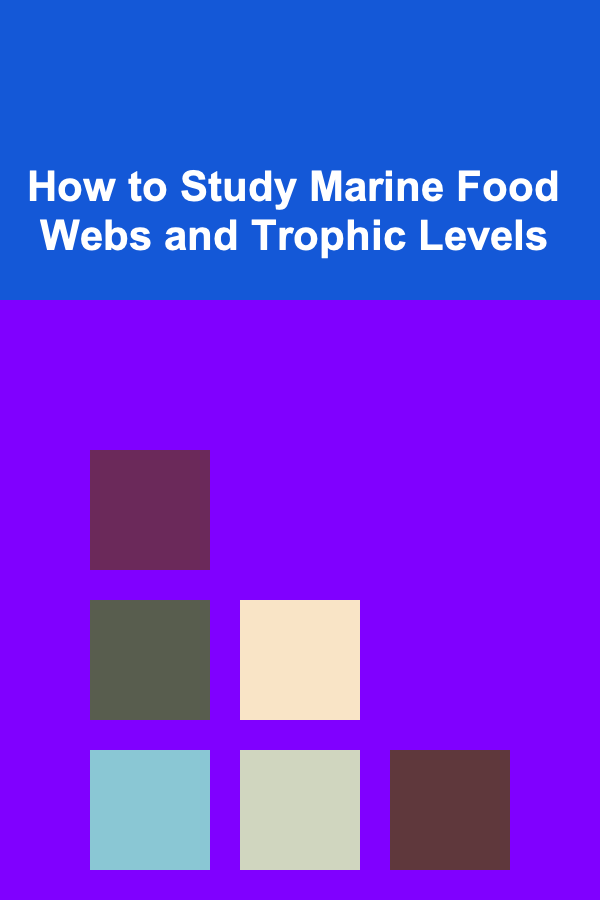
How to Study Marine Food Webs and Trophic Levels
ebook include PDF & Audio bundle (Micro Guide)
$12.99$5.99
Limited Time Offer! Order within the next:

Marine ecosystems are complex and dynamic, supporting a variety of organisms that interact with each other in intricate ways. These interactions form the foundation of marine food webs, which are essential for understanding the flow of energy and nutrients through oceans. Trophic levels represent the hierarchical levels in a food web, where organisms are grouped based on their primary source of energy. To study marine food webs and trophic levels is to uncover the hidden connections and dependencies that sustain marine life.
In this article, we will explore how to study marine food webs and trophic levels in depth. We will cover the basic concepts, methods of study, key factors affecting these webs, and the implications of understanding marine trophic dynamics.
Introduction to Marine Food Webs
A food web is a representation of the feeding relationships among organisms in an ecosystem. Marine food webs are typically structured in a complex, interconnected network, consisting of primary producers (like phytoplankton), herbivores, carnivores, and decomposers. These webs demonstrate the movement of energy through various levels of consumption and highlight the interdependence of organisms in an oceanic environment.
Trophic Levels in a Marine Food Web
The term "trophic level" refers to an organism's position in the food chain, based on its feeding relationships. The levels are generally divided as follows:
- Primary Producers: These are typically photosynthetic organisms such as phytoplankton and seaweeds that convert sunlight into energy. They form the base of the food web.
- Primary Consumers (Herbivores): These organisms feed on primary producers. In marine ecosystems, this category includes zooplankton, small fish, and invertebrates.
- Secondary Consumers (Carnivores): These predators feed on herbivores. Examples include larger fish, squid, and certain types of marine mammals.
- Tertiary Consumers (Top Predators): These organisms are at the top of the food chain and have few or no natural predators. They often include apex predators like sharks, killer whales, and large marine mammals.
- Decomposers and Detritivores: These organisms break down dead plant and animal matter, returning nutrients to the system. Bacteria, fungi, and scavengers such as crabs or certain fish fill this role.
Importance of Studying Marine Food Webs
Understanding marine food webs is essential for several reasons. They are key to the functioning of marine ecosystems and help us comprehend how energy is transferred through the environment. Food webs also play a crucial role in regulating the populations of species and maintaining biodiversity. Additionally, studying these webs can inform us about the effects of human activities such as overfishing, pollution, and climate change on ocean ecosystems.
Methods to Study Marine Food Webs
Studying marine food webs requires an interdisciplinary approach that combines field observations, laboratory experiments, and advanced technologies. Here are the primary methods used to study marine food webs:
2.1 Field Observations and Sampling
One of the most direct methods of studying marine food webs is to observe and sample the organisms in the ecosystem. Researchers use a variety of tools and techniques to collect data on species populations, feeding behaviors, and interactions.
- Plankton Nets: Used to collect plankton, which form the base of many marine food webs. Researchers can analyze the abundance and diversity of phytoplankton and zooplankton populations.
- Fish Traps and Nets: These are used to capture fish and other marine organisms, allowing researchers to analyze the species present and their sizes.
- Benthic Sampling: Benthic organisms, such as crabs, sea cucumbers, and worms, are studied by collecting sediment samples from the ocean floor to examine their role in marine food webs.
2.2 Stable Isotope Analysis
Stable isotope analysis is a powerful tool for studying the feeding relationships in marine food webs. By analyzing the ratio of stable isotopes (e.g., carbon and nitrogen isotopes) in organisms, researchers can track the flow of energy through different trophic levels.
- Carbon Isotopes (δ13C): Carbon isotopes can reveal the primary source of an organism's food. For example, different primary producers (like phytoplankton or seagrass) have distinct isotopic signatures.
- Nitrogen Isotopes (δ15N): Nitrogen isotopes increase in concentration as one moves up the food chain. This allows scientists to determine an organism's trophic level by examining its nitrogen isotope ratio.
2.3 Ecological Modeling
Ecological modeling is used to simulate and analyze food web dynamics. By creating mathematical models of marine ecosystems, scientists can predict how changes in one part of the food web (such as the decline of a predator) might affect other species. These models incorporate data from field studies, laboratory experiments, and stable isotope analysis to estimate energy flow and trophic interactions.
- Food Web Models: These models represent the feeding relationships between organisms, including the transfer of energy across trophic levels. They help to visualize the structure of marine food webs and predict how different species will interact under various scenarios.
- Ecosystem Modeling: This method looks at entire ecosystems and models how environmental changes (such as temperature shifts or pollution) affect the entire food web. It's useful for understanding how global changes impact local marine ecosystems.
2.4 DNA Barcoding and Metabarcoding
Advances in molecular biology have introduced DNA barcoding and metabarcoding as valuable techniques for studying marine food webs. These methods use genetic material to identify species in samples of water, sediment, or digestive contents.
- DNA Barcoding: This method involves sequencing a short genetic marker to identify species. It is particularly useful for identifying cryptic species or organisms that are difficult to distinguish based on morphology.
- Metabarcoding: In this technique, multiple species are identified simultaneously from environmental samples. This allows researchers to study the diversity of organisms in a particular area, even if they do not physically capture the species.
2.5 Radioactive Tracers and Feeding Experiments
Another method for studying trophic levels involves introducing radioactive isotopes into marine organisms and tracking their movement through the food web. This can reveal how energy is transferred between different trophic levels.
- Radioactive Tracers: By labeling certain foods with radioactive isotopes (e.g., carbon-14 or phosphorus-32), researchers can trace the movement of these nutrients through organisms at different trophic levels.
- Feeding Experiments: Controlled experiments in which researchers offer specific food types to organisms and track the consumption and digestion of these materials. This helps understand the direct feeding relationships and energy flow between species.
Factors Affecting Marine Food Webs
Several environmental factors influence the structure and function of marine food webs. Changes in these factors can disrupt trophic dynamics, leading to imbalances or shifts in species populations.
3.1 Ocean Temperature and Climate Change
Climate change has a profound impact on marine ecosystems, including food webs. Rising sea temperatures, ocean acidification, and shifts in ocean circulation patterns can alter the abundance and distribution of species at various trophic levels.
- Temperature Effects on Primary Producers: Warmer waters may benefit some species of phytoplankton, while harming others. This could lead to changes in the composition of primary producers in the food web.
- Shifts in Predator and Prey Populations: Temperature changes can affect the metabolism and reproduction of marine animals. Predators may migrate to different areas in search of prey, disrupting established food webs.
3.2 Overfishing and Depletion of Apex Predators
Overfishing, particularly of apex predators such as sharks and large fish, can have cascading effects on marine food webs. When top predators are removed from an ecosystem, prey populations can increase unchecked, which may lead to the depletion of lower trophic levels.
- Trophic Cascade: A trophic cascade occurs when the removal or reduction of a predator leads to a series of changes throughout the food web, affecting both prey species and the primary producers they feed on.
3.3 Habitat Destruction and Pollution
Habitat degradation, such as coral reef destruction, coastal development, and plastic pollution, can severely disrupt marine food webs. Pollutants like oil, heavy metals, and pesticides can accumulate in organisms, affecting their health and ability to reproduce. This can cause imbalances in the food web and lead to the decline of species at multiple trophic levels.
- Eutrophication: The excess of nutrients from agricultural runoff can lead to the overgrowth of algae, depleting oxygen levels in the water and harming marine life. This can disrupt the entire food web by removing critical primary producers and altering the availability of food for herbivores.
The Role of Marine Food Webs in Ecosystem Services
Marine food webs are not just important for understanding species interactions but also play a crucial role in providing ecosystem services. Healthy food webs support biodiversity, contribute to fisheries, regulate nutrient cycling, and maintain water quality.
- Nutrient Cycling: Decomposers in the food web break down organic matter, recycling nutrients back into the ecosystem. This maintains the nutrient balance required for primary producers to thrive.
- Fisheries: The stability of marine food webs directly impacts commercial fisheries. A collapse of the food web can lead to fishery declines, which not only affects marine life but also the livelihoods of people dependent on fishing industries.
Conclusion
Studying marine food webs and trophic levels offers insights into the complex and interconnected nature of ocean ecosystems. By utilizing various methods such as field sampling, stable isotope analysis, ecological modeling, and DNA barcoding, scientists can unravel the feeding relationships that sustain marine life. Understanding these dynamics is crucial for conserving marine biodiversity, managing fisheries, and mitigating the effects of human-induced changes like climate change and overfishing.
As our understanding of marine food webs deepens, we are better equipped to protect and preserve the delicate balance of life in the ocean, ensuring that future generations can continue to rely on the many services these ecosystems provide.

How to Keep Important Documents Secure and Accessible
Read More
How to Organize Your Recipe Collection for Quick Meal Prep
Read More
How to Sell Handmade Wooden Crafts on Instagram: An Actionable Guide
Read More
How to Teach Blockchain Technology
Read More
How to Interpret Mythological Trees and Plants
Read More
Understanding Your Pet's Nutritional Needs: A Comprehensive Guide
Read MoreOther Products

How to Keep Important Documents Secure and Accessible
Read More
How to Organize Your Recipe Collection for Quick Meal Prep
Read More
How to Sell Handmade Wooden Crafts on Instagram: An Actionable Guide
Read More
How to Teach Blockchain Technology
Read More
How to Interpret Mythological Trees and Plants
Read More